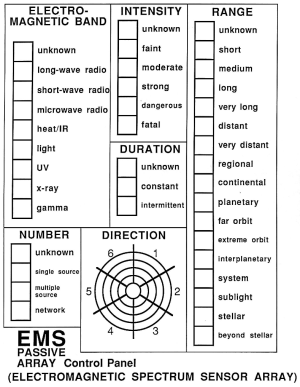LBB2.81, p32 (lightly modified to eliminate wargaming measurements in favor of in-world distances instead):
Having had more time to think about this particular question/problem

... I'm finding this particular answer increasingly UNSATISFYING.

The reason that I say that is because it's "too flat" of an answer to the question. It makes everything "the same" in 2 categories, resulting in a gross oversimplification that KILLS variety in design specs. One of those "you can have any color you want so long as it's BLACK" kinds of deals.
That said, the excessively simplified rule DOES provide some parameters to work with for creating a more nuanced house rule that respects precedent without overstepping it. If people like what I'm about to propose, I can cross-post a copy of this notion into the House Rules Forum where it can be easily found and referenced, rather than needing to dig through this topic thread to find this exact post.
Detection
Craft in space can detect other craft or objects out to a detection radius of (own computer model+Target Size DM+1) * 0.2 light seconds (60,000 km), with a minimum of 0.2 light seconds (60,000 km) detection radius.
TARGET SIZE DM (To Hit) from LBB5.80, p45 and p47:
Hull Size Code | DM |
0 (zero) | -2 |
1 to A | -1 |
B to K | 0 |
L to P | +1 |
Q+ | +2 |
Planetary masses and stars will completely conceal a craft from detection.
This eliminates the distinction between "civilian vs military/paramilitary/scout" ships and puts everything onto a basis of "how powerful is your computer?" installed in your craft. Low powered computers have short detection (and tracking) ranges.
The only real modification here from precedent is to incorporate the Target Size DMs from LBB5.80, p45 into the mix.
Silent Running
- Craft in space that are maintaining complete silence with zero acceleration reduce the detection range radius to 1/2.
- Craft in space that are maintaining complete silence with zero acceleration while in orbit around a world reduce the detection range further from 1/2 (open space) down to 1/8 (due to being in orbit).
This makes it easier for small craft to "hide" by running silently and more difficult for LARGE craft to conceal themselves through silent running.
Tracking
- Civilian sensors: Once a craft has been detected, it can be tracked until exceeding 1.5x the detection radius.
- Scout/Military sensors: Once a craft has been detected, it can be tracked until exceeding 2x the detection radius.
This (home brew) ruling is a very different paradigm from that used in LBB2.81, p32. It means that Tracking radius is a variable (dependent upon computer) rather than a constant (3.0 light seconds for everyone, regardless of type), because the radius for Tracking can range from 0.3 light seconds (Civilian) all the way out to 4.0 light seconds (Model/9).
This House Rule yields a much more "textured" view of detection and tracking, to better enable "cat vs mouse" paradigms in game play when dealing with hunter vs hunted situations.
Silent Running makes it possible to "get closer" without being detected (the point and purpose of "stealth"), but size of craft becomes an important consideration for "how quiet" a craft can be to evade detection. If the purpose is to make a "sneak attack" then it's really a question of getting "close enough" to deploy whatever it is you've got in mind before you can be detected.
One casualty of such a house rule rewrite, however, is that Scout/Couriers (with their model/1bis computers) no longer have "awesome sensors" compared to civilians. However, an obvious solution to that problem is upgrade the computer installed in Scout/Couriers from model/1bis to a model/2 (for example).






